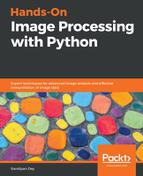In image processing, (local) features refer to a group of key/salient points or information relevant to an image processing task, and they create an abstract, more general (and often robust) representation of an image. A family of algorithms that choose a set of interest points from an image based on some criterion (for example, cornerness, local maximum/minimum, and so on, that detect/extract the features from an image) are called feature detectors/extractors.
On the contrary, a descriptor consists of a collection of values to represent the image with the features/interest points (for example, HOG features). Feature extraction can also be thought of as an operation that transforms an image into a set of feature descriptors, and, hence, a special form of dimensionality reduction. A local feature is usually formed by an interest point and its descriptor together.
Global features from the whole image (for example, image histogram) are often not desirable. A more practical approach is to describe an image as a collection of local features which correspond to interesting regions in the image such as corners, edges, and blobs. Each of these regions is characterized by a descriptor which captures the local distribution of certain photometric properties, such as intensities and gradients. Some properties of the local features are as follows:
- They should be repetitive (detect the same points independently in each image)
- They should be invariant to translation, rotation, scale (affine transformation)
- They should be robust to the presence of noise/blur/occlusion, clutter, and illumination change (locality)
- The region should contain interesting structures (distinctiveness), and suchlike
Many image processing tasks, such as image registration, image matching, image stitching (panoramas), and object detection/recognition use local features. The following diagram demonstrates the basic idea:

In this chapter, we are going to use python-opencv (the cv2 library) for the first time. In order to install it properly, it is recommended you go through this link: https://opencv-python-tutroals.readthedocs.io/en/latest/py_tutorials/py_setup/py_setup_in_windows/py_setup_in_windows.html.
As usual, let's start by importing all the required libraries:
from matplotlib import pylab as pylab
from skimage.io import imread
from skimage.color import rgb2gray
from skimage.feature import corner_harris, corner_subpix, corner_peaks
from skimage.transform import warp, SimilarityTransform, AffineTransform, resize
import cv2
import numpy as np
from skimage import data
from skimage.util import img_as_float
from skimage.exposure import rescale_intensity
from skimage.measure import ransac
